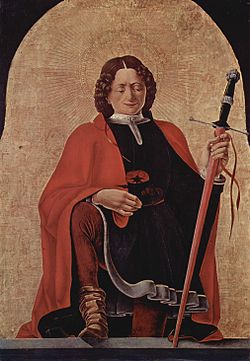- Saint Florian
-
For the city in Austria, see Sankt Florian.For Saint Florian of Chur, see Florinus of Remüs.For the town in Alabama, see St. Florian, Alabama.
Saint Florian 
Saint Florian, 1473 painting by Francesco del Cossa.Died ~303 AD
Enns RiverHonored in Roman Catholic Church
Eastern Orthodox Church[1]Feast May 4 Attributes depicted as a Roman officer or soldier; pitcher of water; pouring water over fire; invoked against fire, floods and drowning[2] Patronage Linz, Austria; chimneysweeps; firefighters; soap boilers; Upper Austria Saint Florian (Latin: Florianus; civil name: Florian von Lorch) (died ca. 304) is a Christian saint, and the patron saint of Linz, Austria; chimney sweeps; and firefighters. His feast day is May 4. St. Florian is also the patron of Upper Austria, jointly with Saint Leopold.
Contents
Life
Florian lived in the time of the Roman emperors Diocletian and Maximian, and was commander of the imperial army in the Roman province of Noricum. In addition to his military duties, he was also responsible for organizing firefighting brigades.[3]
The Roman regime sought to eradicate Christianity, and sent Aquilinus to persecute Christians. When Aquilinus ordered Florian to offer sacrifice to the Roman gods in accordance with Roman religion, he refused, and cheerfully accepted the beatings of the soldiers, who used clubs, spikes and fire to torture him. He was executed by drowning in the Enns River with a stone tied around his neck.[4]
Later a woman named Valeria had a vision in which she saw him; Florian, in this vision, declared his intent to be buried in a more appropriate location.
Veneration
Saint Florian was very widely venerated in Central Europe.[5] The Austrian town of Sankt Florian is named after him. According to legend, his body was interred at St. Florian's Priory, around which the town grew up.
Pope Lucius III, in 1184, is reported to have given some of the saint's relics to Casimir II of Poland and to the Bishop of Kraków. Kraków thus claims some of his relics.[5]
A statue of Florian by Josef Josephu was unveiled in Vienna in 1935. It stood at the main firehouse of Vienna, in the city's main square, Am Hof. After the firehouse was bombed in 1945 during World War II the statue was moved to the Fire Brigade Museum (Wiener Feuerwehrmuseum).[2]
Seeking the sponsorship of a helpful saint was a part of the namegiving practice in Catholic areas. It was important to select a saint that might protect them against their main fears; for example, animal plague(s) and fire. In the southern, Catholic parts of the German Empire (mainly present Bavaria and Austria), peasants regularly have used the name, Florian, as one of the given names for at least one of their male children: to secure the saints patronage against fire. Hence the given name is still widespread in these areas.[citation needed] In Austria, fire services use Florian in radio communications as universal call sign for fire stations.
Folk saying
The "Florian Principle" (known in German language areas as "Sankt-Florians-Prinzip") is named after a somewhat ironic "prayer" to Saint Florian: "O heiliger Sankt Florian, verschon' mein Haus, zünd' and're an", translating to "O holy Saint Florian, spare my house, kindle others". This saying is used in German much like the English "not in my back yard", when the speaker wants to point out that some person tries to get out of an unpleasant situation by an action that will put others in that very same situation. The name Florian is considered a stereotypical name for a fireman in the German speaking world. In some cases call for a fireman will actually be spoken as calls for Florian.
Gallery
-
Bas-relief of St. Florian|Bas-relief of St. Florian on the Florian Gate of Kraków.
See also
- St. Florian's Church in Krakow, the resting place of St. Florian's relics
References
- ^ (Greek) Ὁ Ἅγιος Φλωριανὸς ὁ Μάρτυρας. 4 Μαΐου. ΜΕΓΑΣ ΣΥΝΑΞΑΡΙΣΤΗΣ.
- ^ a b S. D. Paramedics: The Patron Saint of the Fire Service: Saint Florian
- ^ Saint Florian, Patron Saint of Firefighters
- ^ Saint Quirinus of Sescia, another saint associated with a Pannonia, was also said to have been executed by drowning with a stone tied around his neck.
- ^ a b St. Florian - Catholic Online
External links
- Abbey of St. Florian, Linz, Austria
- Catholic Online article
- The Cult of St. Florian (with primary sources)
- St. Florian's Abbey in Austria
- Saint Florian, Patron Saint of FireFighters
- Saint Florian the patron saint of the fire service
- Saints of Suds
- Maltese (i.e. Florian's) Cross symbols on historic firefighting objects, Staten Island Historical Society Online Collections Database
Categories:- 3rd-century births
- 304 deaths
- 4th-century Christian saints
- Austrian saints
- Austrian Roman Catholic saints
- Eastern Orthodox saints
- Firefighting
- German saints
- German Roman Catholic saints
- People executed by drowning
Wikimedia Foundation. 2010.





